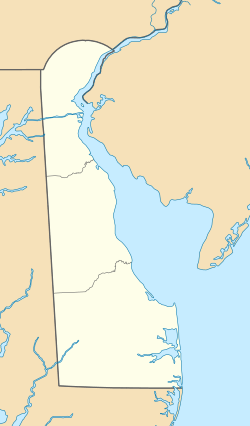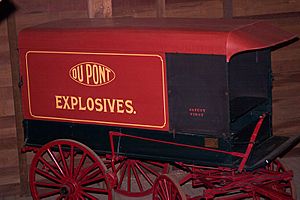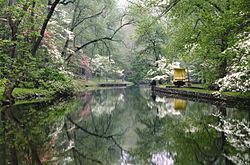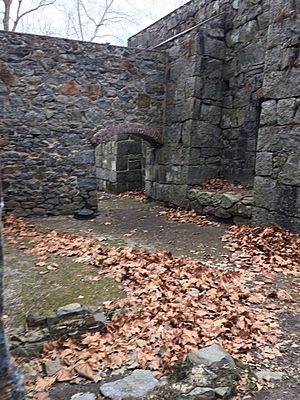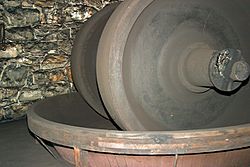Eleutherian Mills facts for kids
|
Eleutherian Mills
|
|
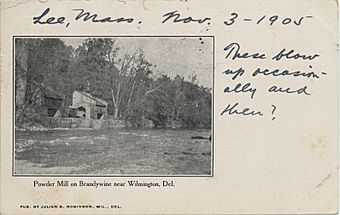
Working powder mills on Brandywine Creek, about 1905. Note the handwritten "These blow up occasionally, and then?"
|
|
| Location | North of Wilmington on Delaware Route 141 at Brandywine Creek Bridge, near Wilmington, Delaware |
|---|---|
| Area | 191.2 acres (77.4 ha) |
| Built | 1803 |
| NRHP reference No. | 66000259 |
Quick facts for kids Significant dates |
|
| Added to NRHP | November 13, 1966 |
| Designated NHL | November 13, 1966 |
Eleutherian Mills was a place where explosives were made. It was a gunpowder mill site used by the Du Pont family business. This business was started by Eleuthère Irénée du Pont. The mills operated from 1802 to 1921.
The name "Eleutherian Mills" also refers to the house on the hill. This house was the first home for the Du Pont family in America. In 1952, the site became an outdoor museum. This museum is now known as the Hagley Museum and Library. In 1966, the site was named a National Historic Landmark.
Contents
History of Eleutherian Mills
In 1795, a man named Jacob Broom built a cotton mill on this land. Sadly, it burned down in 1797. In 1802, Broom sold the land to Eleuthère Irénée du Pont. The price was $6,740 for 95 acres. The site already had a working dam and a millrace.
E.I. du Pont and his family came from France in 1800. They were escaping the French Revolution. In 1802, E.I. du Pont started his company, E. I. du Pont de Nemours and Company. This company made the first high-quality gunpowder in the United States.
They built the Eleutherian gunpowder mill on the Brandywine Creek. This was just north of Wilmington, Delaware. They used gunpowder machinery bought from France. The French government also gave them plans for the mill. They built homes for 30 workers too.
At first, they fixed damaged gunpowder. They also cleaned saltpetre for the U.S. government. Soon, they started making gunpowder themselves. Saltpetre was cleaned in an area between the house and the mills. This area is now a garden. Charcoal was made from willow trees along the Brandywine.
By the end of 1804, DuPont had sold 39,000 pounds of powder. The next year, sales tripled. The government and John Jacob Astor's American Fur Company became regular buyers. In 1813, DuPont bought the Hagley property. This land was just downstream from the first mills. This purchase doubled the size and production of the mills. Sales grew during the Mexican–American War and the Crimean War. During the American Civil War, the company sold 4,000,000 barrels of powder to the government.
The DuPont Family's Role
Eleuthere Irenee Du Pont arrived at Eleutherian Mills in the spring of 1802. He began building a black powder mill, a barn, and a home. His wife and three children joined him in July 1802. By 1803, their home was finished. This house became the center of business and social life at Eleutherian Mills.
E.I. DuPont often traveled for business. His oldest son, Albert Victor, managed the mills when he was away. Members of the DuPont family ran the powder mills until they closed in 1921. They still hold important jobs in the E.I. du Pont de Nemours and Company today. Pierre S. du Pont (1870–1954) was a great-great-grandson of P.S. Du Pont. He started what is now Longwood Gardens.
Life at Eleutherian Mills
Eleutherian Mills was home to the Du Pont family for many years. It was also home to the people who worked for them. The early DuPont family included E.I. DuPont, his wife Sophie, and their eight children. Other family members lived in New Jersey. The DuPont household also included people who were not related to the family. These were people who worked for the family in their home.
These household workers mainly did tasks around the house. After slavery and indentured servitude ended, many workers were family members of those working in the powder mills. Usually, fathers taught their children at home. But E.I. DuPont traveled a lot. So, his older children, especially Victorine, taught their younger siblings. Victorine went to a special school when she was 13. By age 15, she was ready to teach her younger brothers and sisters.
Powder mill workers and their families also lived nearby. Some lived in towns close to the mill yard. Others lived on DuPont property along the Brandywine. These worker communities had private family homes. There were also small villages of houses. Larger buildings rented living spaces to employees.
The "Upper Banks" was the name for the first powder yards. It also included the main DuPont house and worker communities upstream. This area was part of the land E.I. DuPont bought in 1802. Many worker homes were damaged by an explosion in 1890. They were later torn down in 1915. Other communities included Charles Banks, Duck Street, and Chicken Alley. There were also Walker's Bank and Henry Clay Village. These communities had taverns, stores, schools, and post offices.
Mill Explosions
Between 1802 and 1921, there were 288 explosions at the mills. These accidents led to the deaths of 228 people. The three most serious explosions happened in 1818, 1890, and 1915. The 1890 explosion was in the Upper Yard. The 1915 explosion happened in the Packing House. The 1818 explosion caused 34 deaths. The 1890 explosion killed 12 people. The 1915 explosion resulted in 30 deaths.
The Mill Site
The buildings where gunpowder was made had strong stone walls on three sides. But the fourth side, facing the Brandywine Creek, had light wooden structures. This design was for safety. If an accident happened, the explosion would go away from other mills and storage areas. It would be directed over the creek.
Water power came from a mill race behind the mills. This also helped keep the mills safe in case of an accident. One water wheel often powered two mills. Water turbines were added in the 1840s.
Alfred Victor du Pont bought more land downstream from Eleutherian Mills. This was to expand the manufacturing site. One of these properties was called Hagley. It became known as the Hagley Yard.
Most of the old industrial buildings are in the Hagley Yard. The mills were used to clean, crush, and mix charcoal, sulfur, and saltpeter. Other mills made metal powder kegs. Some were used for glazing and corning (shaping) gunpowder. There were also cotton and woolen manufacturing areas. Stables, offices, a machine shop, and a steam powerhouse were also part of the complex. A narrow gauge railway was there too.
Closure and Museum
The mills were supposed to close in the 1910s. This was because smokeless powder became popular. But the federal government asked them to stay open. They continued making gunpowder until after World War I.
In 1952, family members gave 185 acres of land. The DuPont company also gave $6,000,000. This money helped create the Eleutherian Mill-Hagley Foundation. It was for a museum of industrial history.
The site was named a National Historic Landmark in 1966. It is located on Delaware Route 141 at the Tyler Mcconnell Bridge. This bridge crosses the Brandywine Creek.


